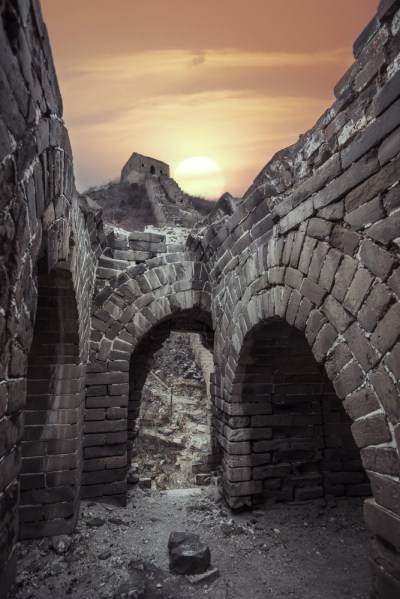
As is so often the case, my troubles began when I got in the stranger’s van.
He seemed like a nice enough guy at the time. He had approached me the day before when I was wandering the streets somewhere between China’s Forbidden City and my hostel, and I was just delirious enough from sustained jet lag, culture shock and hunger that talking to a stranger who approached me on the street seemed like a swell idea. The man offered a full-day tour of the Great Wall for only fifty dollars US, and since he:
A) spoke good English.
B) was not attempting the “art student” scam.
I was so grateful that I immediately signed up for the tour. He took twenty bucks as a deposit, and told me to meet him in the parking lot of a hotel the next morning at 9 AM for the tour.
It was sometime after this conversation that I realized I had given a charismatic stranger twenty dollars for nothing besides a vague promise of having a “very authentic” Great Wall experience. I comforted myself over being so expertly swindled by stress-eating an oatmeal raisin granola bar in my extra-supplement private room while I tried (and failed) to ignore the sounds of people talking and laughing and getting ready for dinner/bars/fun through the thin hostel walls. I also tried not to hate the people who were making those noises and having that fun, but I failed at that, as well.
I had been in Beijing for three days, and I had not experienced a single moment of fun in that entire time. I had not even eaten in a restaurant. Instead, I subsisted entirely on a carefully rationed box of granola bars my mom had packed in my suitcase. Because (in a perfect encapsulation of my early twenties) I was far too terrified to go into a local restaurant and far too proud to ask for help or go to a McDonald’s.
The next day I woke early, and since I had no other plans besides stretching my last granola bar out over three meals and pretending to enjoy myself at another tourist attraction, I decided to check on the very remote possibility that the Great Wall tour was not a scam. And after an hour and a half in Beijing traffic, I arrived at the designated meeting place, only forty-eight minutes after the appointed time.
Amazingly, the tour guide was not only there, but the van had still not left. It was not because they were waiting for me; the seven-person van was already full of seven tourists. And not wanting to miss out on another thirty dollars, the tour guide graciously offered me his seat in the van. Then, after another quick speech about the “authenticity” of our upcoming Great Wall experience, the tour guide gave us a friendly wave goodbye as the driver steered us through the parking lot and merged into the full fury of Beijing gridlock.
It was soon after this that I realized some difficult truths:
Difficult truth #1: This tour no longer had a tour guide.
Difficult truth #2: The driver spoke zero English.
Difficult truth #3: The rest of the people in the van spoke just a slight bit more than zero English (not that I felt they “ought to” — though the tour guide speaking English was what sold me).
Difficult truth #4: I had left my granola bar in the hostel.
The other members of the tour were from Spain, and though I had learned to speak a halting, unpleasant version of Spanish thanks to years of dogged determination (supplemented by obscene amounts of tuition money), my confidence had been so thoroughly thrashed by my three hungry, lonely days in China, that I could not muster the gumption to speak. Instead, I rested my head against the smudged window, and I stared at the city gridlock that eventually transitioned into trees and hills and open fields, and I thought about how everything had gone so wrong, so fast on my post-college adventure. I had set out to find myself, and, so far, I did not particularly like what I had discovered.
After two hours of driving (and a brief pee stop where I bought a box of something that looked somewhat similar to granola bars from a gas station) we pulled off the asphalt and onto a dirt road. Then, after a hundred bumpy yards, we arrived at a gate that looked like this.

A woman in a jacket that was far too large for her stood by the gate — looking like she had been waiting for us for hours. The driver nodded at the woman, rolled down the window, and handed her some folded bills. I didn’t know how much money he had handed her, but the woman appeared satisfied with the amount and opened the gate. As we drove through the gate and onto an even bumpier road, I wondered if the man had just paid an entrance fee or a bribe. Then I thought about the sign that had been posted on the fence. And though I could not read Chinese, I was now entirely sure that it had said “NO TRESPASSING.”
If I had done some (or any) research, I would have known that the Great Wall of China stretches over 13,000 miles long, and most visitors are brought to refurbished, tourist-friendly sections like Badaling. These areas have become some of the most widely-attended tourist destinations on earth, with amenities like Starbucks, dancing bears and rollercoasters, along with the overwhelming negatives (and crushing crowds) that amenities like Starbucks, dancing bears and rollercoasters bring.
If I would have known that a normal trip to the Great Wall was a crowded mess of tour buses, vendors and exploited bears, I am sure I would have been grateful for the “authentic” section I found after the driver parked in a grass field at the bottom of a hill, and I hiked a half-hour through thin branches and thick spider webs. But instead, I only felt confusion that the wonder of the world I expected…

Which instead looked like this…

I felt confused. Confused and more than a little anger about wasting thirty dollars.
I wanted to complain to the driver, but he was sleeping back in the van, and he wouldn’t understand me anyway. And while I tried to formulate the proper assembly of Spanish words for, “hey, if we all yell at the driver for long enough, maybe he’ll give us our money back and drive us to whatever the Chinese equivalent of Chili’s is!”
It was at that moment, boiling with anger, that I noticed that everyone else on the tour appeared happy. They seemed glad that we had spent fifty dollars and three hours driving to a heap of decaying bricks. As I seethed, they scampered up the steep, deteriorating path, laughing and taking pictures.
Since my only other choice was to hike back to the van for a grumpy-nap alongside the driver, I followed after them. I didn’t follow them for long; that section of the Great Wall was fenced off for a reason, and the reason was that it was falling apart and incredibly goddamn dangerous. But sometime between sweating through my hoodie during the ascent, and scraping my nose on ancient stone as I wall-hugged my way across a very thin section with a very tall drop, I realized something:
I was no longer thinking about how strange everything was, or how scary everything was, or how hungry I was, or how lonely I was, or why things weren’t the way I wanted them to be. Instead, I only thought about not dying. I was living in the moment, not because I wanted to, but because I didn’t have any other choice.
I didn’t keep climbing the wall, because “living in the moment” or not, that seemed completely stupid. Instead, I sat on the steps, and I thought about how old the bricks were that supported my ass cheeks, and how far I was from home, and the many challenging, unpleasant, and necessary experiences that lay ahead of me in this country.
As I stared at the winding grey line of the Great Wall cutting across the mountains in the horizon, I realized that I wasn’t exactly happy but I was no longer completely miserable either. That almost felt better than being happy somehow.
So if you ever find yourself in China (and you should), and you want to visit the Great Wall (and you should do that, as well), then please do not follow my example and go to a condemned section, no matter how persuasive the man who approaches you on the street is about its “authenticity.” I also recommend that you skip the crowds and the pumpkin spice lattes at the more popular sections of the Great Wall, as well.
Instead, follow the example of the people in this video below to have an unforgettable and authentic experience on the Great Wall of China, without risking a single compound fracture or concussion by way of errant selfie stick.
And in the end, isn’t that what travel is all about?






